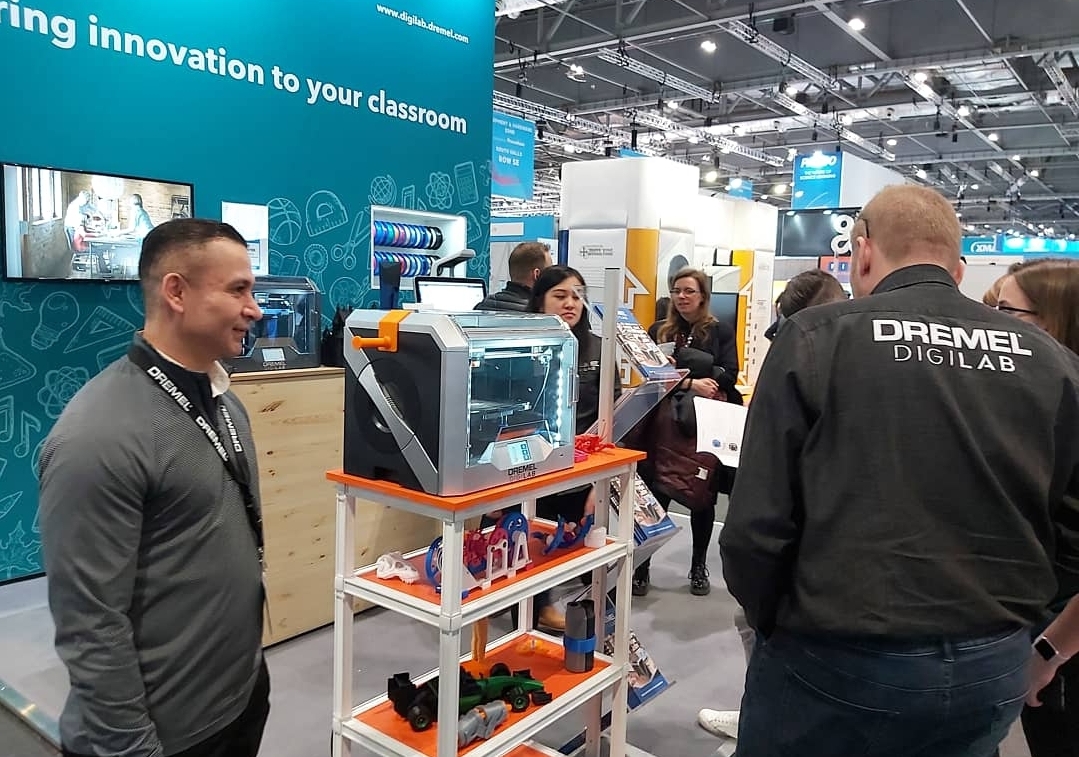We visited the BETT 2020 education technology industry show at London Excel to see the latest trends in 3D printing for the education sector and learn how the technology features on the current curriculum. Among the 800 plus companies exhibiting were the booths of 3D printing companies including Dremel, MakerBot, and CraftBot partner Maker’s Red Box. 3D Printing Industry spoke with experts and D&T teachers who told us how they intend to bring 3D printers into more schools.

3D printing is essential for the next generation of manufacturing professionals
Additive manufacturing is becoming an industry norm for the engineering sector, according to Nick Longford, Head of Business Development, Dremel DigiLab. Longford said,
“In the future, maybe 10 years from now, students who don’t understand 3D printing, they are not going to be able to get a job in the engineering industry. Boeing, Airbus, aerospace and automotive companies are heavily investing in 3D printing at the moment.”
Allison Mazzetti, MakerBot Product Manager believes, it is essential to get familiar with the 3D printing technology already at school, especially for those who are planning to become engineers. “This is where the manufacturing engineering industry is going, the fields where they are going to work in.”

How 3D printing supports design thinking
The new challenges of the future require different skills. Dremel expert Nick Longford said, “the possibility to understand and pick up the 3D printing concept at a young age puts a serious advantage for the future generation since this technology is going to be a part of the world they come out to.”

Knowing the logic of 3D printing technology is not only advantageous for future engineers but can help any students to understand subjects better, like mathematics, geography or arts. Differences in learning styles are subject of debate, for example, whether a student favors a visual or kinesthetic learning approach. According to Longford, being able to touch and feel how the parts of three-dimensional figures interact and not only seeing them in books makes the principles easier to grasp for previously struggling students.
3D printing also empowers the skill of creativity and problem-solving, since the technology provides access to the design process. Supporters of Design Thinking in education state, this approach, encourages students to become more inquiring and think divergently. Razzouk’s research (2012) shows higher-order thinking skills can be gained through the design cycle than via more traditional learning activities.
According to Ineta (2014), the steps of the design process start with discovering and identifying challenges by brainstorming, gathering information, generating potential solutions, then refining and testing them. The process is circular, each stage should be revisited, while the constant iteration develops critical thinking and reflexivity.
The process of 3D printing a product allows students to understand the links between rapid prototyping, testing, evaluating, modifying and repeating. During this cyclical process, students gain necessary and real-world skills, as they need to understand the appearing problems and find a possible solution to redesign and make a new version of their work. Moreover, with 3D printing, they can do it in a relatively short time.
The companies at BETT 2020 are clear about the advantages of 3D printing for education, but does the technology make it into the classroom?
CraftBot partner Maker’s Red Box is designing curriculums to prepare students for the predicted challenges of the future, combining the technologies of 3D printing, laser cutting, and microelectronics. The Budapest-based company created its City of the Future course for makerspaces, aiming to introduce students urban development concepts like governance and sustainability.

What’s next for 3D printing in education?
Dremel DigiLab already states, 2020 is the year for them in education. Head of the company’s Business Development Nick Longford told us, they are going to launch an ambassador program to make schools become advocates. Longford added, “We are going to be producing a huge amount of case studies to influence more schools and universities to take up 3D printing”.
Phil Hall, 3D Printing Industry Award-winning Design & Technology teacher of Windsor Boys School believes 3D Printing should be part of the curriculum. “We want it to be in every school in the UK and globally, that’s the dream” – said the educator. Hall added, “forward-thinking schools already invest heavily in 3D printing technology. The main issues to get it into education are mostly financial, and yet the curriculum is not enforcing the technology to the classroom – whether to embrace it is still left to the teacher, who does not necessarily have the skills to teach 3D printing.”
Windsor Boys School was one of the 21 institutes receiving a 3D printer from governmental funding in 2012, when the school received a MakerBot Replicator to teach complex maths and scientific ideas. The 3D printing manufacturer company already launched its Certification Program to provide middle and high school students with 3D printing design and skills training. Product Manager Allison Mazzetti added, in 2020 MakerBot is planning to be widely distributed in more schools.”
At BETT 2020, MakerBot was promoting its guidebook, enabling teachers to learn and apply 3D printing, to take students from starting 3D printing to getting them prepared for work.
For more reports on the biggest technology events, subscribe to the 3D Printing Industry newsletter. You can also keep connected by following us on Twitter and liking us on Facebook.
If you would like to apply for a position or hire an expert in the industry, visit our 3D Printing Jobs board.
Featured image shows BETT 2020 attendees. Photo by 3D Printing Industry.


